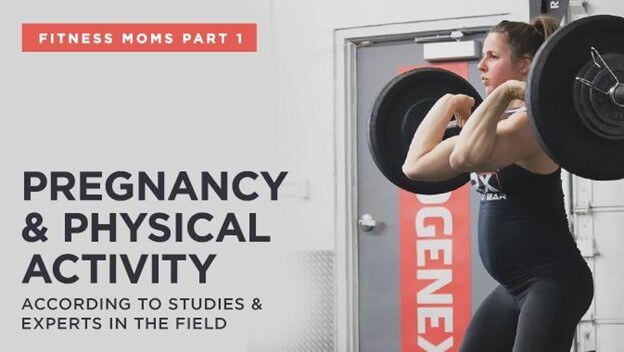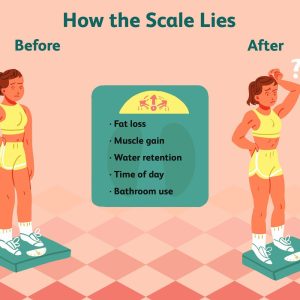Fitness While Pregnant
There is an undeniable connection between healthy mothers and healthy infants. Debates on the benefits and potential risks of pregnancy & exercise have been gaining public attention across media and social media in the past few years, with strongly voiced pro and con opinions. While some are based on research findings, most appear to be based on gut, culturally and socially rooted opinions and what is deemed appropriate by each and every one’s standards and education on the matter.
Let’s add functional fitness to this already spicy mix. Functional fitness has always been a controversial subject due to the high intensity involved in the workouts, perceived by many as raising the risk of injuries, despite studies showing the injury risk per thousand hours actually being lower than in some endurance sports such as running. But as functional fitness is maturing as a sport discipline, its athletes are maturing together with it, making room for other issues critiques love picking on. We’ve witnessed the first generations of Games athletes hang up their competition shoes, but continuing high volume training. We’ve seen some of them start families and continue thriving in sports after cute little juniors appeared in the picture. As this appears to be a top subject for people hungry for controversy, we’ve found some research and decided to share the results of a few studies with you, to get a clearer view over physical activity during the prenatal and postpartum periods.
In this article we will discuss physical exercise in the prenatal period, including the benefits of exercising during pregnancy for the future mom and for the fetus, which exercises are recommended and which are to be avoided, how to scale according to each trimester and what are the body’s caloric requirements during pregnancy. We will dedicate a separate article to discuss fitness in the postpartum period.
What does research say about exercising and pregnancy
In the study “Benefits of Exercise during Pregnancy”, authors Heidi Prather, Tracy Spitznagle and Devyani Hunt reviewed over 125 research papers on the subject, published after the year 2002, and summarized their findings for a better understanding of the benefits of exercise on the mother, the fetus and the newborn.
It’s important to know that already in 2002 The American College of Obstetrics and Gynecologists recommended that, during pregnancy, women should perform 30 minutes or more of moderate-intensity exercise on most, if not all, days of the week. Despite of the fact that this recommendation became known worldwide, even nowadays many healthy pregnant women are either not advised about the benefits of exercise or choose not to engage in physical activity exercise. Moreover, it has been reported that both previously active healthy women and also inactive women are at low risk for adverse fetal or maternal events when engaging in routine physical activity during pregnancy. The study says that “after becoming pregnant, women generally tend to decrease their activity levels because of lack of motivation, perceived lack of time due to family and work demands, desire to postpone weight loss until after delivery, and pain with movement.”
Looking at the big picture though, aerobic exercise, some forms of strength training, stretching and yoga have all been repeatedly reported to be safe to perform when pregnant. When it comes to aerobic training, there’s a wide variety of exercises to choose from: stationary bicycling, jogging, walking, stair climbing, treadmill, water gymnastics, swimming, and aerobic dance classes – all of them having been used by pregnant women with no adverse effects.
Speaking about duration, women have reported to exercise between 12 weeks onwards throughout their entire pregnancy. The frequency of aerobic exercise participation among future moms is most commonly 3-5 times per week with sessions ranging from 15 minutes up to 150 minutes per session. According to the studies reviewed, 60 minutes or longer has been found to be safe for the mother and the fetus. The intensity of aerobic exercise can be safely monitored by using self-pacing techniques or heart rate monitoring using 50%-75% of the age-predicted maximum. An estimate of a person’s maximum age-related heart rate can be obtained by subtracting the person’s age from 220.
Benefits of exercising for the future mothers
Let’s look at the benefits for the mothers who exercise during pregnancy. These include improved cardiovascular function, a lower risk for gestational diabetes in both women who don’t suffer from obesity, but also in those who do suffer from it, improved strength and lean muscle mass, improved sense of well-being, and better quality sleep.
Weight gain during pregnancy is a natural and necessary process. But excessive gestational weight gain is associated with maternal complications, including cesarean delivery, hypertension, preeclampsia, impaired glucose tolerance and gestational diabetes.
The benefits are clear: the prevention of excessive weight gain (a key factor in the intergenerational transmission of obesity) and a lower risk of fetal macrosomia (babies who are born weighing more than 4 kilograms), pre-eclampsia, gestational diabetes, caesarean section, lower back pain, pelvic pain and urinary incontinence.
Moreover, there is no risk of premature birth, low birth weight or fetal distress, provided that the mother has no medical or obstetric contraindication for physical exercise.
The benefits of exercising for the fetus
Now let’s take a look at the benefits of mothers exercising during pregnancy for the fetus. These include decreased resting fetal heart rate, improvement in the viability of the placenta and increased amniotic fluid levels. This effect of exercise has been postulated to possibly provide protection against preeclampsia. However caution is suggested at exercise intensities above 90% of heart rate maximum.
Children of women who exercise during their pregnancy have lower birth weights, increased gestational ages, and potentially improved neurodevelopment. Newborns of exercising mothers had a lower percentage of body fat.
The study lead by Heidi Prather states that “although research in the neurodevelopment of infants born to active mothers is still limited, recently Apgar scores have been found to be higher in neonates who are born to exercising mothers.”
The risk of not engaging in physical activity
Along the course of history, more recently than not, pregnant women were advised to refrain from exercise because of concerns on fetal risk. Simultaneously, they were advised to increase their caloric intake during pregnancy. Recently, despite of the fact that a lot of new studies have proved the benefits of prenatal exercise, most pregnant women do not meet the recommended guidelines for physical activity. This is a real problem because low exercise rates have been proven to increase the risk for glucose intolerance of variable degree and subsequent obesity, Type 2 diabetes, and cardiovascular disease.
A high maternal weight is associated with a higher birth weight of the newborn and contributes to the intergenerational transmission of obesity. Consequently, pregnancy has evolved as a major contributor to the worldwide obesity epidemic. Besides the risk of excessive weight gain, inactive pregnant women are more prone to pre-eclampsia, gestational diabetes, caesarean section, lower back pain and urinary incontinence.
The physical activity and pregnancy literature have evolved sufficiently over the last 50 years and there is currently enough empirical evidence to support the promotion of moderate to vigorous prenatal physical activity for maternal health benefits.
Moreover, there are proofs that exercise should be taken not only by healthy, previously active women, but that it is also a good time to adopt a healthy lifestyle by women who had rather sedentary lifestyles pre-pregnancy. Studies show there are clear advantages for both the mother and the baby.
“The percentage of women who meet the recommendations for exercise during pregnancy is very low,” says María Perales, the lead author of “Exercise During Pregnancy” and a researcher from the department of Physical Activity and Sports Science at Camilo José Cela University (UCJC). She continues saying the lack of physical activity is due to the uncertainty regarding exercises that are recommended and those that need to be avoided.
Which physical exercises are recommended and which should be avoided?
New studies highlight the physical activity patterns which have proven to be most beneficial during this period, as well as the exercises which these women should avoid as they might pose a risk to the fetus.
When it comes to the type of exercise, duration and weekly frequency, the experts stress the importance of combining aerobic and strength training in each session, which should last between 45 to 65 minutes.
The intensity should always be moderate and it should be analyzed for each woman and controlled throughout the session. Physical activity can be started between week 9 and 12 of pregnancy (after the first prenatal visit), generally until week 38-39.
Techniques such as Pilates and yoga, often recommended during this period, are not linked to the physiological benefits described, but have shown improvements in mental health and pain reduction.
In terms of exercises which should be avoided, “all that is strenuous (90% or more of maximum heart rate), since it may increase the risk of hypothermia, dehydration or reduced uterine blood flow with the associated risk of compromising the fetus’ health,” Perales stresses.
Similarly, long-distance running, intense weight and isometric contraction training, jumps, impact exercises and exercises with risk of falling or requiring lying on your back, must be suspended.
Prenatal functional fitness exercising
Based on all of the afore mentioned sources and conclusions, functional fitness exercising falls right under the category of recommended exercising during pregnancy. If you have already interacted with the functional fitness community and culture, you know that many performance athletes in this sport have recently become pregnant, among which are 8 times Games Athlete Stacie Tovar, 6 times Games athlete Emily Bridgers, 2017’s Second Fittest Woman on Earth Kara Saunders and the list can continue. All these ladies have continued exercising during their pregnancy, doing the Open workouts and scaling whenever it was necessary.
Currently Stacie Tovar is in her 32nd week of pregnancy and still works out 5 times a week together with the group classes and scaling almost everything.
We’ve done some research on each trimester among future moms and coaches training pregnant women and we’re happy to share with you what’s to expect, how to scale and most importantly, how to listen to your body, as this is the best indicator on how your scaling should be. The recommendations below are applicable to women doing functional fitness already before the pregnancy. If you are starting functional fitness after you became pregnant, make sure you talk to your doctor in advance and let your coach know you’re pregnant before starting the classes.
Doing functional fitness in your first trimester
Training in the first trimester can be similar to what you were doing before the pregnancy. For women doing functional fitness regularly, maintaining your regular weights should be ok, but be careful at the overall intensity. This is a time to maintain your fitness, rather than improve it. The lifts involving maximum effort and those workouts involving high intensity need to be approached with moderate efforts. Aim for a level of intensity that feels like a 7-8 on a 1 to 10 scale and change one rep max lifts to 3 less loaded lifts. The best “test of moderation” is talking during a workout. If somebody asks you “How do you feel?” your should be able to answer with a sentence, rather than scattered words among convulsive breaths. In the first trimester it is still safe to perform such exercises as bench press or sit ups, if you feel perfectly fine doing them.
One thing you will have to consider is your morning sickness. There is a chance this will appear in the first trimester and you will have to listen to your body and adapt your workouts schedule accordingly. Going to the afternoon class will be a much better choice than working out while feeling nausea in the morning.
Continuing functional fitness in your second trimester
Once you’ve entered your second trimester, around week 20, you will start noticing more changes which will signal scaling and adapting to your new condition. It is advised to avoid lying down on your back for a long period, because the uterus can be at this moment large enough to obstruct the needed blood supply to you and the fetus. Notice your body while bench pressing – if you feel light headed when you get up from the bench, take it as a sign from your body to stop this exercise until after birth. Avoid sit-ups, as they present a risk of diastasis recti.
Another change is your increasing belly. Consider each exercise from the perspective of feeling safe and comfortable performing the movements involved. Avoid exercises that have a risk of falling such as rope climbs, kipping pull ups, box jumps, handstand walks or push ups, basically anything inverted. It’s time to modify dynamic lifts, especially those that involve squatting. This is a time to decrease intensity a little, and just like in the first trimester, you should feel comfortable enough to answer any question during your training without gasping for air. Keep an open dialogue with your coach and listen to your body.
Continuing functional fitness in the third trimester
Keep listening to your body and adapting based on the same logic you’ve had during the second trimester. Just like before, movements that involve the risk of falling should be avoided. Your balance may feel at times odd, depending on your joints. Take your comfort level into consideration every time the belly might get in the way. Lower the level of intensity more, as needed. Find your pace and decrease intensity as you feel it. A good workout doesn’t mean doing the same exercises as before pregnancy, but remember only moving in the gym is gold. If you’re still going regularly to the gym in your third trimester, give yourself a pat on the back, you’re doing a great job for you and your baby, both physically and mentally.
Pregnancy Nutrition: Weight Change And Calories
By the time you are ready to give birth, your total blood volume will grow by as much as 60%. Your breasts will be filled with milk. Your uterus will grow to accommodate your baby and it will be filled with amniotic fluid. Your baby’s weight will be between 2.7 to 4.5 kilograms (6 – 10 pounds), on average. To accomplish all of these changes, your body needs approximately 300 extra calories per day during your 2nd and 3rd trimester of pregnancy. Below, you can find an approximation of nutrients needed during pregnancy.
Protein
Experts recommend 75 to 100 grams of protein per day. Protein positively affects the growth of fetal tissue, including the brain. It also helps your breast and uterine tissue to grow during pregnancy, and it plays a role in your increasing blood supply.
Calcium
The daily requirement of calcium is around 1000 milligrams during pregnancy. Calcium helps your body regulate fluids, and it helps build your baby’s bones and tooth buds.
Iron
In combination with sodium, potassium, and water, iron helps increase your blood volume and prevents anemia. A daily intake of 27 milligrams is ideal during pregnancy.
Folic acid
Folic acid plays a key role in reducing the risk of neural tube defects, including spina bifida. Experts recommend 600 to 800 micrograms (.6 to .8 milligrams) daily.
Vitamin C
Fruits and vegetables rich in Vitamin C will promote wound healing, tooth and bone development, and metabolic processes. Experts recommend at least 85 milligrams per day.




